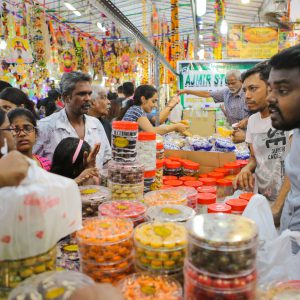Merchants, Minions, and the Military
October 22, 2022

Diwali, better known as Deepavali in Singapore, is the Hindu festival of lights. It will take place for five days, starting from the 22nd of October this year. One of the major annual celebrations in Hinduism, the festival symbolizes the triumph of light and goodness over darkness and evil; an annual reminder to all Hindus not only of their religion, but also of their cultural ties to their ancestral home.
Associate Professor Rajesh Rai (NUS South Asian Studies) examines the formation of an Indian diaspora in Singapore from 1819 to 1867 in ‘Merchants, Minions, and the Military’, a chapter in Indians in Singapore, 1819-1945: Diaspora in the Colonial Port-city (Oxford University Press, 2014).
The chapter explains the three main reasons Indians traders and merchants flocked to the city during Singapore’s early colonial period:
(1) The city was situated at the centre of traditional Indian commercial routes and offered a profitable alternative to the monopolistic Dutch controlled ports.
(2) The lucrative India-China and Malay Archipelago trade of the East India Company, the increasingly dominant commercial power at the time, required European and Indian collaboration centred on Singapore.
(3) Singapore’s rapid economic development eventually elevated its prestige and status above previous commercial centres such as Riau and Penang for Indian traders.
A/P Rai details the military component of early Indian settlers, who acted as both law enforcement for the fledgling colony as well as participating in infrastructure projects such as clearing land and other public works. These soldiers often grew wealthy through money-lending and participating in the slave trade, which they either kept for their own use or exposed to prostitution for remuneration.
Apart from the colonial military, the other Indians that arrived on the island largely consisted of Tamils, Parsis, and Chettiars. The Tamils constituted the most significant Indian group in terms of commercial activity and were involved in a wide variety of trades such as textiles, gems, cattle, leather, tobacco, and so on. The Parsis were significantly smaller in scale, with only 35 recorded by 1871, but occupied important political positions such as serving within the Grand Jury that was otherwise excluded for all other Indians. Lastly, there were the Chettiars, who were commonly associated with money-lending activities, as British banks refused to extend credit to any non-Europeans on the island with the sole exception of certain top-ranking Chettiar financiers.
The early Indian diaspora in Singapore was overly male in composition, with the proportion of Indian women amongst the population estimated to be as low as 3% between 1821 and 1860. It was also overwhelmingly comprised of Indians coming from Tamil and Chettiar regional backgrounds (the states of Tamil Nadu and Kerala in South India). This South Indian heritage would go on to form the basis of the culture and identity of modern Indian-Singaporeans today.
Read the full chapter here.
